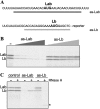Mechanisms governing the selection of translation initiation sites on foot-and-mouth disease virus RNA
- PMID: 21813609
- PMCID: PMC3196443
- DOI: 10.1128/JVI.05085-11
Mechanisms governing the selection of translation initiation sites on foot-and-mouth disease virus RNA
Abstract
Translation initiation dependent on the foot-and-mouth disease virus (FMDV) internal ribosome entry site (IRES) occurs at two sites (Lab and Lb), 84 nucleotides (nt) apart. In vitro translation of an mRNA comprising the IRES and Lab-Lb intervening segment fused to a chloramphenicol acetyltransferase (CAT) reporter has been used to study the parameters influencing the ratio of the two products and the combined product yield as measures of relative initiation site usage and productive ribosome recruitment, respectively. With wild-type mRNA, ∼40% of initiation occurred at the Lab site, which was increased to 90% by optimization of its context, but decreased to 20% by mutations that reduced downstream secondary structure, with no change in recruitment in either case. Inserting 5 nt into the pyrimidine-rich tract located just upstream of the Lab site increased initiation at this site by 75% and ribosome recruitment by 50%. Mutating the Lab site to RCG or RUN codons decreased recruitment by 20 to 30% but stimulated Lb initiation by 20 to 40%. An antisense oligodeoxynucleotide annealing across the Lab site inhibited initiation at both sites. These and related results lead to the following conclusions. Recruitment by the wild-type IRES is limited by its short oligopyrimidine tract. At least 90% of internal ribosome entry occurs at the Lab AUG, but initiation at this site is restricted by its poor context, despite a counteracting effect of downstream secondary structure. Initiation at the Lb site is by ribosomes that access it by linear scanning from the original entry site, and not by an independent entry process.
Figures







Similar articles
-
Construction of regulatable picornavirus IRESes as a test of current models of the mechanism of internal translation initiation.RNA. 2001 May;7(5):647-60. doi: 10.1017/s1355838201001911. RNA. 2001. PMID: 11350029 Free PMC article.
-
The properties of chimeric picornavirus IRESes show that discrimination between internal translation initiation sites is influenced by the identity of the IRES and not just the context of the AUG codon.RNA. 1999 Jun;5(6):764-78. doi: 10.1017/s1355838299982158. RNA. 1999. PMID: 10376876 Free PMC article.
-
The influence of downstream protein-coding sequence on internal ribosome entry on hepatitis C virus and other flavivirus RNAs.RNA. 2001 Apr;7(4):585-97. doi: 10.1017/s1355838201000589. RNA. 2001. PMID: 11345437 Free PMC article.
-
Cap-independent translation of picornavirus RNAs: structure and function of the internal ribosomal entry site.Enzyme. 1990;44(1-4):292-309. doi: 10.1159/000468766. Enzyme. 1990. PMID: 1966843 Review.
-
Hepatitis C Virus Translation Regulation.Int J Mol Sci. 2020 Mar 27;21(7):2328. doi: 10.3390/ijms21072328. Int J Mol Sci. 2020. PMID: 32230899 Free PMC article. Review.
Cited by
-
Translation of Overlapping Open Reading Frames Promoted by Type 2 IRESs in Avian Calicivirus Genomes.Viruses. 2024 Sep 4;16(9):1413. doi: 10.3390/v16091413. Viruses. 2024. PMID: 39339889 Free PMC article.
-
Multifunctional roles of leader protein of foot-and-mouth disease viruses in suppressing host antiviral responses.Vet Res. 2015 Oct 28;46:127. doi: 10.1186/s13567-015-0273-1. Vet Res. 2015. PMID: 26511922 Free PMC article. Review.
-
Modification of the second translation initiation site restricts the replication of foot-and-mouth disease virus in PK-15 cells.Appl Microbiol Biotechnol. 2020 Oct;104(19):8455-8466. doi: 10.1007/s00253-020-10810-w. Epub 2020 Aug 21. Appl Microbiol Biotechnol. 2020. PMID: 32820373 Free PMC article.
References
-
- Bergmann J. E., Lodish H. F. 1979. Translation of capped and uncapped vesicular stomatitis virus and reovirus mRNAs. Sensitivity to m7GpppAm and ionic conditions. J. Biol. Chem. 254:459–468 - PubMed
Publication types
MeSH terms
Substances
Grants and funding
LinkOut - more resources
Full Text Sources
Other Literature Sources
Research Materials
Miscellaneous

